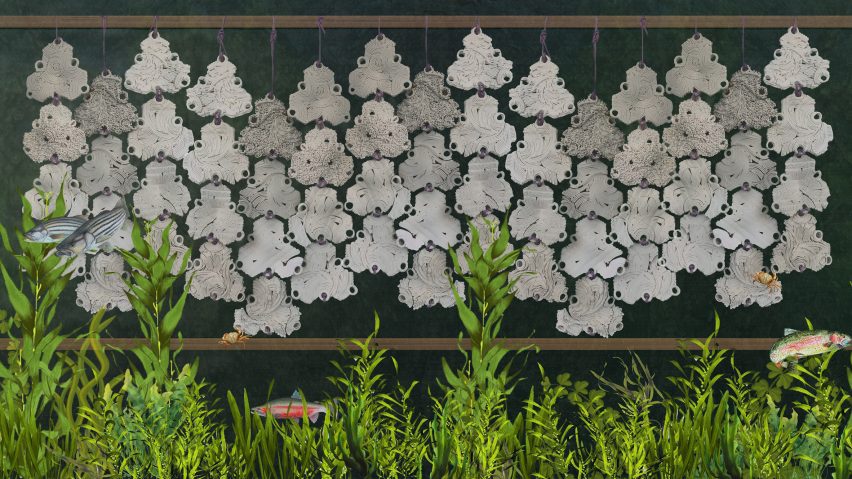
California College of the Arts presents 10 architecture student projects
Dezeen School Shows: a tech recycling centre built on the site of an Apple store in downtown San Francisco is included in Dezeen's latest school show by students at California College of the Arts.
Also featured is a project proposing digitally manufactured submarine habitats for oysters and fish, and a pavilion that can be used as a yoga pod or meditation tent.
California College of the Arts
Institution: California College of the Arts
School: Architecture Division
Courses: Bachelor of Architecture, BFA Interior Design, Master of Architecture and Master of Advanced Architecture Design
Tutors: Neeraj Bhatia, Nataly Gattegno, Negar Kalatnar, Janette Kim, Adam Marcus, Brian Price, Margaux Schindler, Alex Schofield, Neal Schwartz, Kristen Smith and Clark Thenhaus
School statement:
"The Architecture Division at California College of the Arts in San Francisco is an arena for the free and open exchange of ideas about the future – of our buildings, cities and planet – and a laboratory where these ideas are tested through speculative architectural and design research.
"Across four academic programmes and four research and teaching labs, our architecture and interior design students design with aesthetic, social, and environmental issues in mind, producing work that links image to identity, form to performance and order to equity.
"The five-year Bachelor of Architecture (BArch) programme is NAAB-accredited and STEM-designated.
"With a focus on critical thinking and creative making, students learn how to be agents of change, leveraging their skills toward environmental, social, and political impact.
"The BFA in Interior Design, is a four-year accredited programme with a focus on sustainable material practices and spatial innovation in which students learn to design for various human environments, including the home, workplace and public sphere.
"Our NAAB-accredited and STEM-designated Master of Architecture (MArch) programme champions innovation and experimentation in architectural design, preparing students to lead conversations and develop solutions around some of the world’s most pressing issues.
"In our STEM-designated Master of Advanced Architectural Design (MAAD) students focus on an independent research or design project through mentored study and a range of elective offerings in one of three areas associated with our acclaimed research labs: Digital Craft, History Theory Experiments, or Urban Works.
"At CCA we are guided by the shared belief that architecture and design are critical cultural practices that can and should serve the common good."
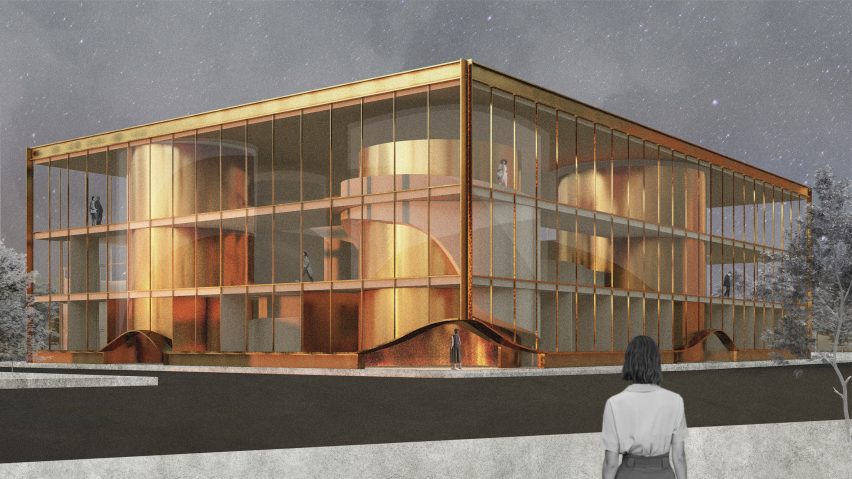
Bodies, Sovereignty and Hysteria by Lizzy Wilson
"As a response to the overturning of Roe vs Wade and the subsequent banning of abortion in multiple states, this thesis takes advantage of the political sovereignty granted to consulates as a legal loophole for placing an abortion clinic in Houston, Texas.
"Exploring the hybrid design of a Norwegian Consulate and an abortion clinic, the consulate encompasses the clinic and acts as a barrier or safe haven for the clinic nested within.
"The exterior of the consulate employs modernist ideas of hyper transparency, as manifested in Philip Johnson's Glass House, and a rigid gridded structure, as found in Mies van der Rohe's Seagram Building.
"However, the internal design of the clinic counters and disrupts the patriarchal design norms of modernism with a different spatial sensibility that does not rely on any datum or grid.
"Instead it is loose, freeform and curvilinear, using curtains as space dividers."
Student: Lizzy Wilson
Course: Master of Architecture Thesis
Tutors: Nataly Gattegno and Brian Price
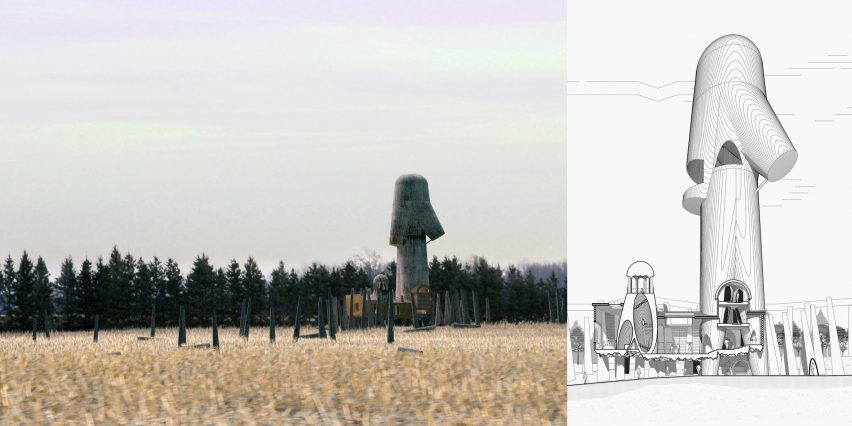
Visitor Center by David Rico-Gomez
"Visitor Center explores notions of rurality and wilderness in American national and regional park building design.
"The National Parks Service has adopted a rustic form of architectural decoration – affectionately dubbed 'parkitechture' – as a guideline for use across its buildings.
"When examined more closely, many of the architectural elements in NPS buildings are lifted from Midwestern rural architecture: farmhouses, four-squares and ranch homes.
"The rurality of the Midwest can not be conflated with wilderness, as its fields are aggressively controlled and domesticated.
"A forest of bioengineered columns elevates the building, while grasses and moss grow between the logs – both inside and out – creating a home for a diverse ecosystem of microorganisms."
Student: David Rico-Gomez
Course: Advanced Architecture Studio: SNAFU
Tutor: Clark Thenhaus
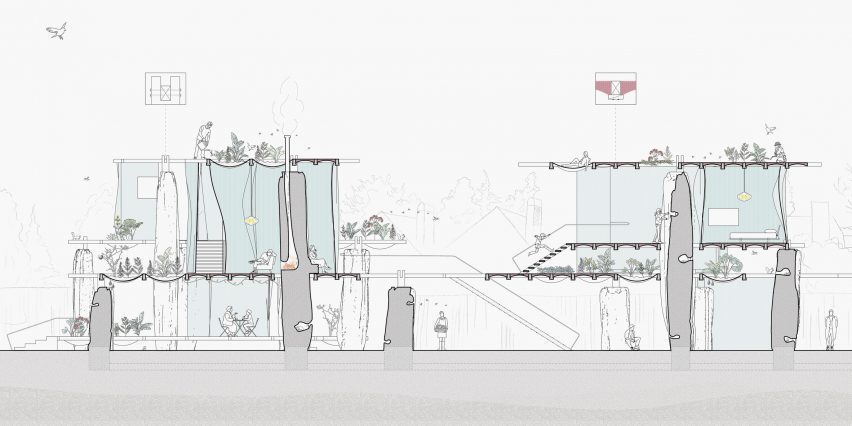
Loosely a House by Claire Leffler and Martin Hitch
"Loosely a House is an experiment in unpredictability and control.
"At the heart of the project is an experimental technique that combines fabric liners with digitally fabricated formwork to shape multi-purpose rammed earth columns, which establish the framework for a versatile habitat that welcomes both human and non-human inhabitants.
"In lieu of traditional walls, the project utilises several types of curtains to flexibly partition spaces. In this way, the distinction between interior and exterior is blurred, allowing human residents to inhabit the structure in a manner reminiscent of birds nesting."
Students: Claire Leffler and Martin Hitch
Course: Advanced Digital Craft Architecture Studio: Materialities of Care
Tutor: Adam Marcus
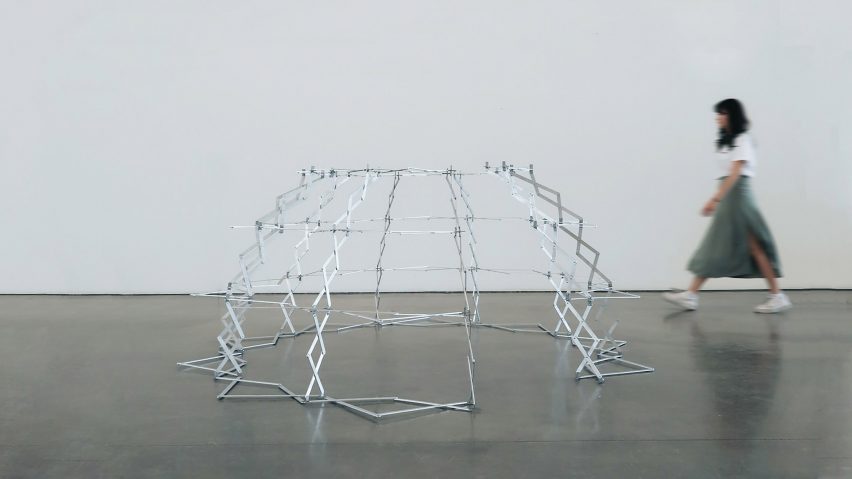
Cupola – A Rapidly Deployable Architecture with Environmental Considerations by Soojee Choi, Owen Patia and Electra White
"Cupola addresses the need for quickly erected, reusable structures.
"The project was designed in CCA Professor Negar Kalantar's transtudio – an ongoing architectural exploration of adaptable structures guided through pedagogies of motion and computational craft.
"Cupola is a rapidly deployable pavilion – useful as a yoga pod or meditation tent – whose unique collapsible design is achieved with overlapping multi-scissor joints that allow for seamless folding and unfolding."
Students: Soojee Choi, Owen Patia, and Electra White
Course: Interior Design Materiality and Space 4: transtudio
Tutor: Negar Kalantar
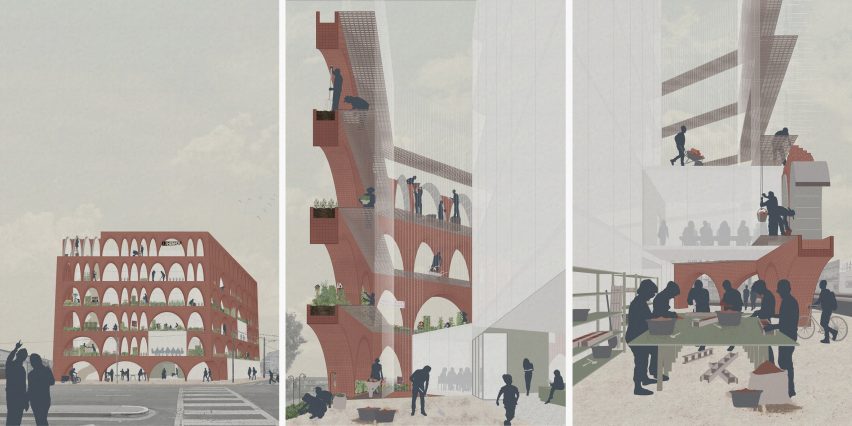
Common Ground by Hannah Leathers
"Common Ground is a response to the unjust way land in West Oakland has been racialised, commodified and polluted due to historical redlining systems, ongoing gentrification and industrial lead contamination.
"Ground is a physical and political resource to which the residents of West Oakland have been continually denied access, whether that's land to freely gather on, outright own, or to farm.
"This proposal acknowledges this narrative and asks how the Library of West Oakland can act as a framework for reclamation of a common ground.
"In this regard, the library acts as a scaffold for land to grow around it, converting traditionally programmed library space into shared ground that the community can call its own.
"This process happens slowly over time as the community comes together to build an earthen-made wall around the library."
Student: Hannah Leathers
Course: MArch Studio 3: Reframing the Public Library
Tutors: Neeraj Bhatia and Nataly Gattegno
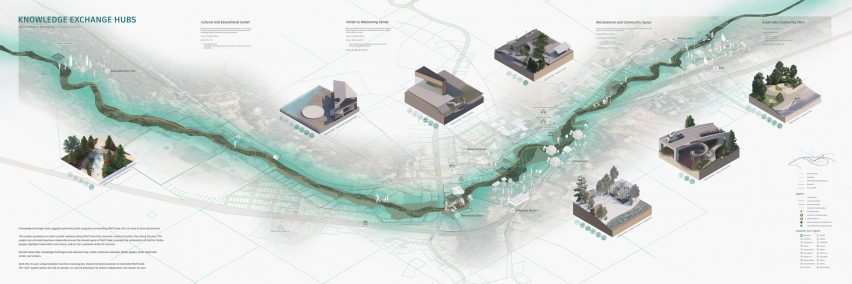
Knowledge Exchange Hubs by Luis Arturo Gomez-Escobedo and Vicky Sindac
"Designed for the town of Greenville, which was destroyed by the Dixie Fire in 2021, Knowledge Exchange Hubs proposes a network of public programmes and amenities along Wolf Creek.
"This infrastructure of community services – connected by a public walkway – will serve to reactivate downtown Greenville and highlight its rich culture, promote the reclamation of land for the indigenous Maidu people, and act as a welcome centre for visitors.
"These linked sites of exchange and interaction will reactivate Wolf Creek and provide multiple platforms – each with its specific programme – for people to connect and build community."
Students: Luis Arturo Gomez-Escobedo and Vicky Sindac
Course: Advanced Urban Works Architecture Studio: Property in Crisis
Tutor: Janette Kim
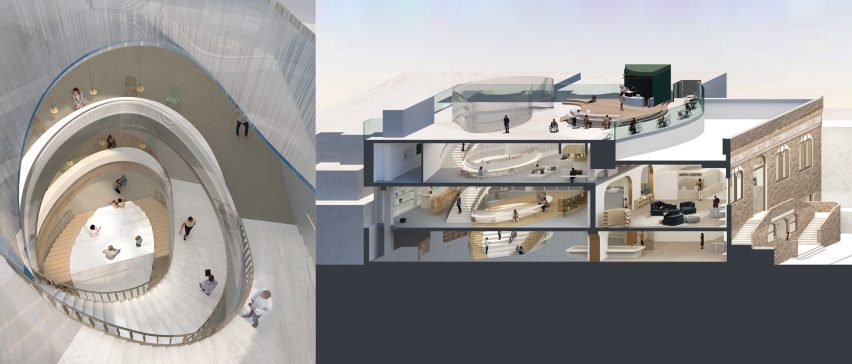
1135 Library by Jun Hee Koh, Suyang Yao and Tatiana Watkins
"Sited within one of the most heavily used branch libraries in San Francisco, 1135 Library preserves the existing facade and reading room of the Chinatown Branch Public Library while reimagining the space for the 21st century.
"Eschewing old ideas of the library as a 'quiet space', this proposal organises multifunctional spaces based upon their intended use and noise levels.
"Flexibility is offered by grouping core support functions and maintaining open floor plates while strategically building in niches of intimate space.
"Connection between each of these programmes is created with an active open staircase which extends from a new accessible entry at the sidewalk level to an open-air roof terrace with views across the city and to the bay."
Students: Jun Hee Koh, Suyang Yao and Tatiana Watkins
Course: Interior Design Advanced Interdisciplinary Studio
Tutor: Kristen Smith
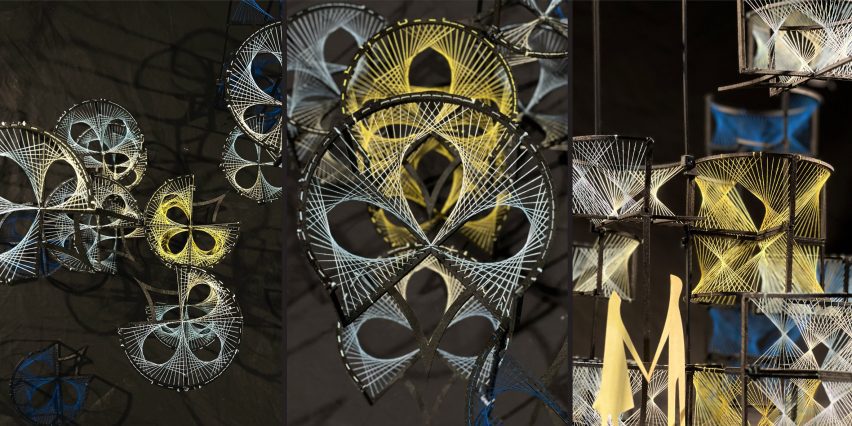
Woven Projections – Adaptive Modular Environment by Xinye Ju
"Inspired by the work and teachings of Anni and Josef Albers, students in the Materiality and Space 3 course in the Interior Design programme transformed 2D pliable surface models into a series of 3D modular woven spatial projections through a set of formal and material experiments.
"The students were guided by considering the resulting environment's performance in relation to air, light, sound and colour.
"Soft and hard modular frame assemblies reconfigure and deconstruct to create interactive, flexible and adaptive interior environments."
Student: Xinye Ju
Course: Interior Design Materiality and Space 3
Tutor: Margaux Schindler
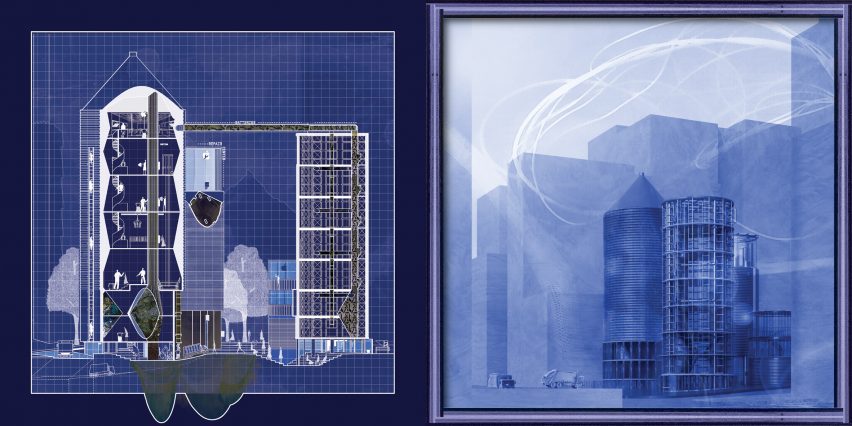
Reimagining E-Wasteland by Ayse Elif Aydinli
"This thesis project proposes a new urban recycling and upcycling centre for e-waste on the site of the existing Apple store in downtown San Francisco’s Union Square.
"The Apple store is one of the most potent symbols of capitalistic materialism, the culture of planned obsolescence, throw-away culture and the aesthetics of consumerist desire.
"The thesis imagines taking over this iconic urban space and transforming it into a new typology of civic infrastructure, one that critically reveals the economic, cultural, and environmental mechanisms that make it function.
"This new civic recycling centre aims to counter the dominant mentality of 'out-of-sight and out-of-mind'.
"It operates from the premise that the buildings that sustain our consumerism should also reveal their operations and infrastructure, and become critical components of our urban environments."
Student: Ayse Elif Aydinli
Course: Master of Architecture Thesis
Tutor: Neal Schwartz
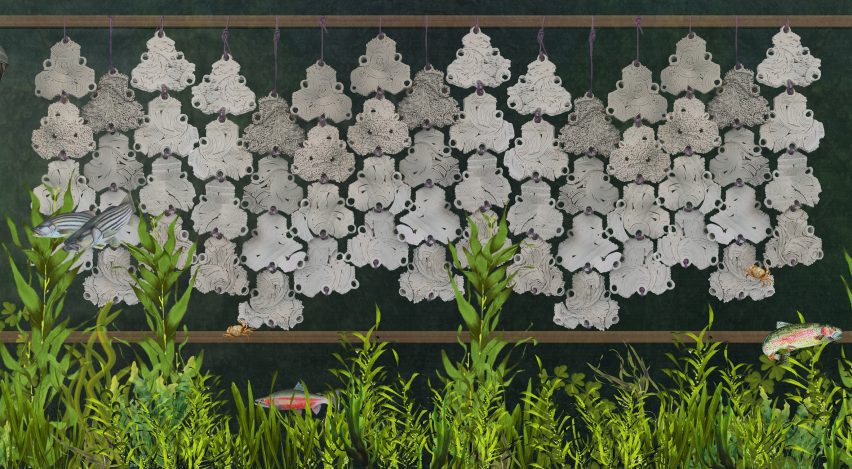
Oyster Shingle by Ahmad Alajmi, Claire Leffler, and Colin Murdock
"The project explores ceramic material assemblies as a locus for expanding architecture’s ecological performance.
"It proposes a system of digitally fabricated modular ceramic systems that can serve as ecological habitat for oysters.
"Drawing on research into the life cycle, geography, ecosystem and habitats of Olympia Oysters, the project explores how artificial substrates might benefit a more biodiverse ecosystem."
Students: Ahmad Alajmi, Claire Leffler, and Colin Murdock
Course: Architecture Elective: Ecological Tectonics
Tutors: Alex Schofield and Adam Marcus
Partnership content
This school show is a partnership between Dezeen and California College of the Arts. Find out more about Dezeen partnership content here.